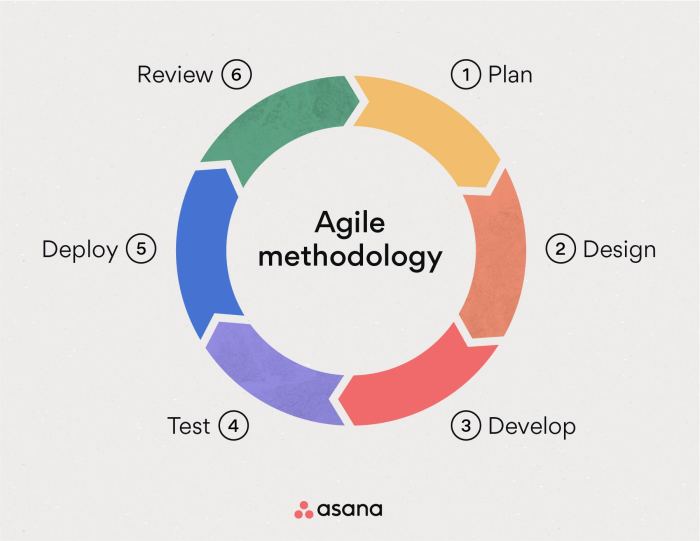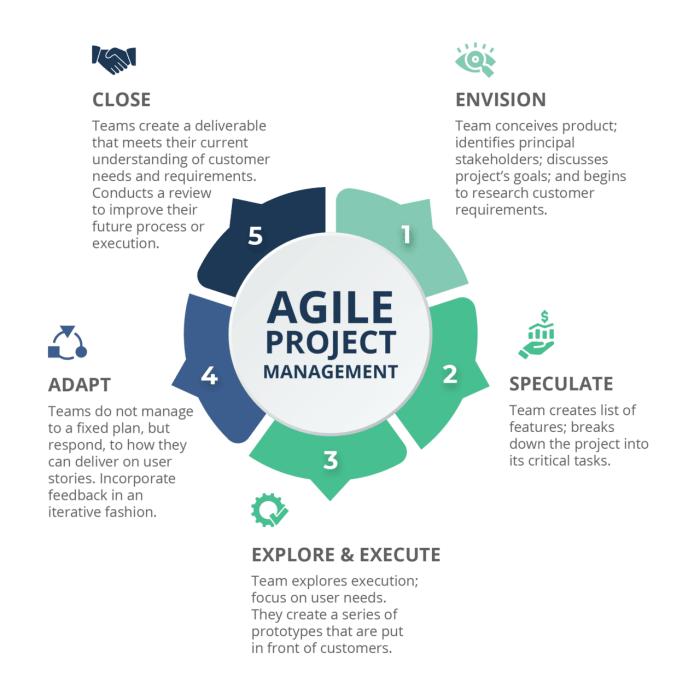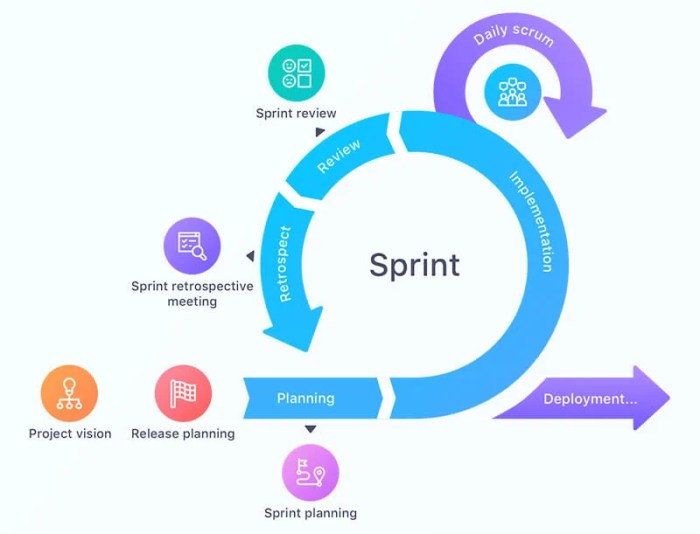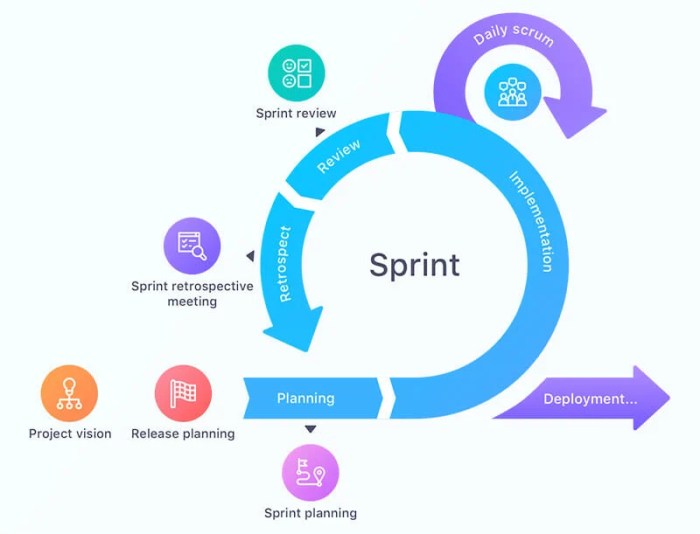Tired of projects going off the rails? Feeling like your team is stuck in a loop of endless deadlines and revisions? Well, buckle up, because Agile Project Management is about to revolutionize your workflow! It’s like the superhero of project management, swooping in to save the day with its flexible, iterative approach.
Think of it as a dynamic dance between planning and execution, where you embrace change and adapt to new information with a smile.
This guide is your ticket to mastering Agile Project Management. We’ll explore the core principles, dive into popular frameworks like Scrum and Kanban, and equip you with the tools and techniques to lead your team to project success. So, get ready to ditch the rigid old ways and embrace the power of Agile!
Introduction to Agile Project Management

Agile project management is a modern approach to managing projects, emphasizing flexibility, collaboration, and continuous improvement. It contrasts with traditional, waterfall methodologies that follow a rigid, linear process. Agile focuses on delivering value incrementally, allowing for adaptation to changing requirements and feedback.
Core Principles of Agile Methodology
Agile methodology is guided by a set of core principles that emphasize collaboration, adaptability, and continuous improvement. These principles ensure that projects are delivered efficiently and effectively, meeting the changing needs of stakeholders.
- Customer Focus:Agile prioritizes understanding and meeting customer needs. Teams work closely with customers to gather feedback and ensure the project delivers the desired value.
- Iterative Development:Agile projects are broken down into small, manageable iterations called sprints or cycles. Each iteration delivers a working product increment, allowing for continuous feedback and adjustments.
- Collaboration and Communication:Agile emphasizes open communication and collaboration among team members, stakeholders, and customers. This ensures everyone is aligned and working towards a common goal.
- Continuous Improvement:Agile teams constantly reflect on their processes and seek ways to improve. This includes identifying and addressing bottlenecks, streamlining workflows, and enhancing team collaboration.
Benefits of Using Agile for Project Delivery
Agile project management offers numerous benefits for project delivery, enabling organizations to respond to changing demands, enhance collaboration, and deliver value faster.
- Increased Flexibility:Agile’s iterative approach allows teams to adapt to changing requirements and market conditions, ensuring the project remains relevant and valuable.
- Faster Time to Market:Agile’s focus on delivering working software increments quickly allows for faster time to market, enabling organizations to gain a competitive advantage.
- Improved Collaboration:Agile fosters a collaborative environment where team members, stakeholders, and customers work together closely, promoting open communication and shared understanding.
- Enhanced Quality:Agile’s focus on continuous feedback and improvement leads to higher-quality deliverables, as issues are identified and addressed early in the development process.
- Increased Customer Satisfaction:Agile’s customer-centric approach ensures that projects meet the needs and expectations of stakeholders, leading to higher customer satisfaction.
Agile Frameworks
Different Agile frameworks provide structured approaches to implementing Agile principles, each with its unique characteristics and strengths.
- Scrum:Scrum is a popular Agile framework that emphasizes teamwork, iterative development, and continuous improvement. It uses sprints, daily stand-up meetings, and sprint reviews to manage project progress.
- Kanban:Kanban is a visual workflow management system that focuses on visualizing work, limiting work in progress, and continuously improving workflow efficiency. It uses boards with columns representing different stages of work, and cards representing tasks.
- Lean:Lean is a philosophy that focuses on eliminating waste and maximizing value. It applies to Agile project management by identifying and eliminating non-value-adding activities, optimizing workflow, and improving efficiency.
Agile Values and Principles

Agile project management isn’t just about using sticky notes and stand-up meetings; it’s about a mindset that prioritizes flexibility, collaboration, and continuous improvement. At the heart of this approach lies the Agile Manifesto, a document that Artikels the core values and principles that guide Agile practices.
Think of it as the Agile Bible, but instead of commandments, it has a set of values and principles that can help you navigate the world of project management.
The Agile Manifesto
The Agile Manifesto, penned in 2001 by a group of software development experts, emphasizes a set of four core values that should guide Agile teams:
- Individuals and interactions over processes and tools:Agile prioritizes the people behind the project and their ability to collaborate effectively over rigid processes and tools. It’s about building strong teams and fostering open communication. Think of it like the Avengers, where individual strengths come together to achieve a common goal.
- Working software over comprehensive documentation:The focus is on delivering functional software that meets the needs of users. While documentation is important, Agile teams emphasize creating working software that provides tangible value. Imagine you’re building a spaceship. You want to get it off the ground and see if it flies, rather than spending years on elaborate blueprints.
- Customer collaboration over contract negotiation:Agile values continuous feedback from customers and stakeholders throughout the project lifecycle. It’s about working together to ensure the project meets their needs, rather than focusing on legal contracts and rigid specifications. Think of it like a collaborative brainstorming session where everyone gets to contribute to the final product.
- Responding to change over following a plan:Agile embraces change and recognizes that requirements can evolve over time. Teams are encouraged to adapt to changing circumstances and deliver value quickly and efficiently. It’s like navigating a maze. You need to be flexible and adapt to the changing landscape to find the exit.
Agile Principles
Building upon these values, the Agile Manifesto Artikels 12 principles that provide practical guidance for Agile teams:
- Our highest priority is to satisfy the customer through early and continuous delivery of valuable software.Agile emphasizes delivering working software early and often, providing customers with tangible value and allowing for feedback and adjustments.
- Welcome changing requirements, even late in development. Agile processes harness change for the customer’s competitive advantage.Agile teams embrace change and are prepared to adapt to evolving requirements. It’s like a basketball game where the strategy changes based on the opponent’s moves.
- Deliver working software frequently, from a couple of weeks to a couple of months, with a preference to the shorter timescale.Agile teams strive for frequent releases of working software, enabling them to gather feedback and make adjustments quickly. Think of it like a TV show that releases new episodes regularly, keeping viewers engaged and providing opportunities for feedback.
- Business people and developers must work together daily throughout the project.Agile teams encourage close collaboration between business stakeholders and developers, ensuring that everyone is aligned and working towards the same goals. It’s like a band where musicians collaborate and practice together to create a harmonious sound.
- Build projects around motivated individuals. Give them the environment and support they need, and trust them to get the job done.Agile recognizes the importance of motivated and skilled individuals. It’s about creating an environment where people feel valued and empowered to contribute their best.
- The most efficient and effective method of conveying information to and within a development team is face-to-face conversation.Agile encourages open and frequent communication, recognizing that face-to-face interactions are often the most effective way to exchange information.
- Working software is the primary measure of progress.Agile teams focus on delivering working software as the primary measure of progress, rather than relying on documentation or reports. It’s like a recipe where the final dish is the ultimate measure of success.
- Agile processes promote sustainable development. The sponsors, developers, and users should be able to maintain a constant pace indefinitely.Agile teams strive for sustainable development practices, ensuring that the team can maintain a consistent pace and avoid burnout. Think of it like a marathon, where pacing is crucial to finishing the race.
- Continuous attention to technical excellence and good design enhances agility.Agile teams prioritize technical excellence and good design, recognizing that it contributes to the long-term maintainability and adaptability of the project. It’s like a well-designed car that runs smoothly and efficiently.
- Simplicity—the art of maximizing the amount of work not done—is essential.Agile encourages simplicity and focuses on delivering the minimum viable product that meets the customer’s needs. It’s about cutting out unnecessary features and complexity.
- The best architectures, requirements, and designs emerge from self-organizing teams.Agile teams are encouraged to self-organize and take ownership of their work. It’s about empowering teams to make decisions and find the best solutions.
- At regular intervals, the team reflects on how to become more effective, then tunes and adjusts its behavior accordingly.Agile teams engage in regular retrospectives to identify areas for improvement and adjust their processes accordingly. It’s like a performance review where the team reflects on their performance and sets goals for the future.
Practical Applications
These values and principles translate into practical project management practices:
- Iterations and Sprints:Agile projects are divided into short iterations, typically lasting a few weeks, called sprints. Each sprint focuses on delivering a specific set of features or functionalities.
- Daily Stand-up Meetings:Teams hold brief daily stand-up meetings to discuss progress, identify roadblocks, and coordinate their efforts. It’s like a quick team huddle to ensure everyone is on the same page.
- Backlog Management:Agile teams maintain a prioritized list of tasks called a product backlog. This backlog is continuously refined and updated based on customer feedback and changing priorities.
- User Stories:Agile teams use user stories to describe the functionality of the product from the perspective of the user. This helps to ensure that the project is aligned with customer needs.
- Continuous Integration and Deployment:Agile teams strive for continuous integration and deployment, meaning that they frequently integrate code changes and deploy updates to the production environment.
- Retrospectives:Agile teams hold retrospectives at the end of each sprint to reflect on what went well, what could be improved, and how to adjust their processes for future sprints.
Agile Project Management Practices

Agile project management practices are the heart and soul of the Agile methodology, providing a framework for teams to work efficiently and deliver value incrementally. These practices are like the ingredients in a delicious recipe, each playing a crucial role in creating a successful project.
Agile Project Lifecycle Stages
The Agile project lifecycle is a continuous process of planning, executing, and reflecting on work. It’s not a rigid waterfall model, but rather a flexible and iterative approach that allows for adjustments based on feedback and changing requirements.
Agile project management is all about staying flexible and adapting to change, just like in the thriller “Borrowed Time” Borrowed Time , where the characters have to constantly adjust their plans to stay ahead of the game. So, if you want to nail your next project, ditch the rigid old-school methods and embrace the agility of Agile.
It’s like having a superpower to handle unexpected twists and turns.
| Stage | Description |
|---|---|
| Planning | The initial stage where the team defines the project scope, goals, and timelines. This involves creating a product backlog, which is a prioritized list of features and functionalities. |
| Iteration (Sprint) | A time-boxed period (typically 1-4 weeks) where the team focuses on completing a specific set of work items from the product backlog. Sprints are the core of Agile development, allowing for frequent delivery of working software. |
| Daily Stand-up Meeting | A short, daily meeting where team members discuss their progress, roadblocks, and plans for the day. It’s a quick and effective way to stay synchronized and address any issues promptly. |
| Sprint Review | A meeting held at the end of each sprint to demonstrate the completed work to stakeholders and gather feedback. This helps ensure that the team is on track and delivering value. |
| Sprint Retrospective | A meeting for the team to reflect on the past sprint, identify areas for improvement, and plan for the next sprint. This is an essential practice for continuous learning and process optimization. |
Agile Team Roles and Responsibilities
Agile teams are typically cross-functional, bringing together individuals with diverse skills and expertise to collaborate effectively. These roles work together to ensure that the project is successful and delivers value to the stakeholders.
- Product Owner:The voice of the customer, responsible for defining the product vision, prioritizing the backlog, and accepting completed work.
- Scrum Master:The facilitator and coach for the team, responsible for removing impediments, ensuring that the team follows Agile practices, and fostering a collaborative environment.
- Development Team:The group of individuals who actually build the product, including developers, testers, designers, and other specialists.
Agile Tools and Techniques
Agile teams utilize a variety of tools and techniques to enhance their workflow and communication. These practices help them to be more efficient, productive, and adaptable.
Agile project management is all about keeping things moving, just like a band jamming out a sweet tune. But before you can rock the project, you gotta get your fundamentals down. Think of it like learning music theory.
You need to understand the basics to create something truly awesome. Check out this book, What You Need to Know Before you Learn Music Theory A practical book that is taught via the piano and is applicable to all instruments , for a solid foundation.
Once you’ve got the basics down, you can start breaking down your projects into smaller, manageable chunks, just like a band would break down a song into sections.
- User Stories:Short, informal descriptions of a feature or functionality from the user’s perspective. They help to break down complex requirements into smaller, manageable pieces.
- Sprint Planning:A meeting where the team selects a set of user stories from the product backlog to work on during the upcoming sprint. This helps to ensure that the team is focused on the most important work.
- Daily Stand-up Meetings:A brief, daily meeting where team members answer three questions: “What did you do yesterday?”, “What will you do today?”, and “What impediments are you facing?”. This keeps everyone on the same page and helps to identify any potential roadblocks.
- Retrospectives:Meetings held at the end of each sprint to reflect on what went well, what could be improved, and how to adapt for the next sprint. This is a critical practice for continuous improvement and learning.
Book Review
This book review will delve into the popular resource “Agile Project Management for Beginners” by [Author Name], offering insights into its strengths and weaknesses, and comparing its approach to Agile with other popular resources.
So you wanna get your project management game on point, right? Agile is the way to go, it’s like the Beyoncé of project management – all about flexibility and getting things done. Want to learn more? Download And Listen Here to get the lowdown on Agile and how to level up your project management skills.
It’s like a cheat code for crushing your goals and making sure your projects are totally on fire.
Summary and Key Takeaways
“Agile Project Management for Beginners” is a comprehensive guide for those new to Agile methodologies. It breaks down complex concepts into digestible pieces, making them accessible to beginners. The book covers the fundamental principles of Agile, including Scrum, Kanban, and Lean, and provides practical examples and case studies to illustrate how these principles can be applied in real-world scenarios.
The book’s key takeaways include:
- Understanding the core values and principles of Agile.
- Learning about different Agile frameworks, such as Scrum and Kanban.
- Developing practical skills for implementing Agile in projects.
- Understanding the benefits of Agile for project success.
Strengths of the Book
“Agile Project Management for Beginners” excels in several areas:
- Clear and concise language:The book uses simple language and avoids jargon, making it easy for beginners to understand complex concepts. It’s written in a conversational style, which makes it engaging and relatable.
- Practical examples and case studies:The book provides numerous real-world examples and case studies to illustrate how Agile can be applied in various industries and project types. These examples help readers visualize how Agile principles translate into practice.
- Step-by-step guidance:The book provides a step-by-step approach to implementing Agile, making it easy for readers to follow and apply the concepts in their own projects.
- Focus on practical skills:The book emphasizes practical skills, such as conducting sprint planning, running daily stand-up meetings, and managing backlog items. This focus on practical skills makes the book valuable for those who want to implement Agile immediately.
Weaknesses of the Book
While “Agile Project Management for Beginners” is a valuable resource, it has some limitations:
- Lack of depth:The book provides a good overview of Agile, but it lacks the depth of more advanced resources. It might not be sufficient for experienced practitioners or those seeking a deeper understanding of specific Agile frameworks.
- Limited coverage of specific frameworks:The book covers Scrum, Kanban, and Lean, but it does not delve deeply into other popular Agile frameworks, such as Extreme Programming (XP) or Feature-Driven Development (FDD).
- Limited focus on Agile scaling:The book primarily focuses on implementing Agile in small to medium-sized projects. It does not provide much guidance on scaling Agile to larger organizations or complex projects.
Comparison with Other Resources
“Agile Project Management for Beginners” is a good starting point for beginners, but it’s important to compare it with other popular resources. For instance, “The Scrum Guide” by Ken Schwaber and Jeff Sutherland provides a more in-depth and authoritative guide to Scrum.
“Kanban: Successful Evolutionary Change for Your Technology Business” by David J. Anderson offers a comprehensive guide to Kanban. “Lean Startup” by Eric Ries provides a framework for building and launching successful products and services. Each of these resources offers a unique perspective on Agile and can complement the information presented in “Agile Project Management for Beginners.”
Agile Project Management is all about being flexible and adapting to change, kinda like how you might adjust your plans when you run into a super-organized neighbor who always has their act together. Speaking of organized, check out this story about a neat and clean married woman in the neighborhood, A neat and clean married woman in the neighborhood Konichiwa from the side (Japanese Edition).
Anyway, back to Agile, the key is to break down projects into smaller chunks and iterate, just like you might tackle a big cleaning project room by room.
Summary
As you embark on your Agile journey, remember that flexibility and collaboration are your secret weapons. Embrace the iterative process, celebrate wins big and small, and never be afraid to adjust your course. With Agile, you’re not just managing projects, you’re building a culture of continuous improvement, innovation, and teamwork.
So, get out there, embrace the Agile mindset, and watch your projects soar!
FAQ Resource
What are some common misconceptions about Agile Project Management?
One common misconception is that Agile is just for software development. While Agile originated in software, its principles are applicable to a wide range of projects, including marketing campaigns, product launches, and even event planning. Another misconception is that Agile is chaotic or lacks structure.
In reality, Agile provides a structured framework for managing projects, with defined roles, processes, and tools.
How can I convince my team to adopt Agile?
Start by highlighting the benefits of Agile, such as increased flexibility, faster delivery times, and improved communication. You can also share real-world examples of successful Agile projects. Finally, involve your team in the decision-making process and give them the opportunity to voice their concerns and ideas.
What are some common challenges faced by Agile teams?
Some common challenges include managing scope creep, ensuring effective communication across team members, and overcoming resistance to change. It’s important to address these challenges head-on and develop strategies for mitigating them.

